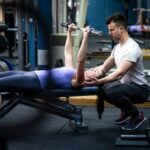
Fitness workouts come in a variety of formats and can be tailored to meet the specific needs of any person. From beginner exercises like walking, stretching, and swimming to more advanced options like weightlifting and high-intensity interval training (HIIT), anyone can find an exercise program that works for them. With tailored guidance from a professional and using the right equipment, individuals can make fitness workouts part of their daily lives and achieve their desired goals.
Strength Training: A Popular Type of Fitness Workout Strength training is a popular type of fitness workout aimed at developing muscle mass and increasing strength, performance, and power. This form of exercise involves using progressive resistance against muscles which causes contraction, leading to increased strength over time.
Exercises such as pushups, squats, lunges, pullups, and weight lifting are all great ways to incorporate strength training into your fitness routine. Using weights comes with additional benefits such as improved coordination, balance, posture, and bone density.
Cardiovascular Exercise: An Essential Part of Fitness Workouts Aerobic or cardiovascular exercise is an essential component in maintaining physical health by improving feelings of wellbeing while enhancing heart health/cardiovascular functioning as well as energy levels.
Running on a treadmill or cycling for 30 minutes on a stationary bike are some examples of cardio that aid long-term overall fitness goals; additionally fitness classes such as dance aerobics or kickboxing provide an enjoyable way to work out different parts of the body while having fun in the process.
Comfortably pushing yourself further with cardiovascular exercise gives you the opportunity to go for longer periods with less intensity which not only burns calories but also helps build stamina over time which will lead to better results when incorporated within your weekly fitness routine.
Benefits of Fitness Workouts
Regular fitness workouts can have a number of benefits, both mentally and physically. Firstly, engaging in regular fitness exercise helps maintain a healthy weight for your age, sex and height. By combining strength training with cardio exercising your body’s metabolism is boosted and helps you to burn or manage calories efficiently throughout the day. Additionally, regular exercise promotes better mental health by releasing feel-good endorphins which reduce depression and anxiety levels.
Types of Fitness Workouts
Fitness workouts can be adapted to suit any fitness level or individual needs; whether you prefer group activities or solo challenges there are plenty of workouts available.
- Aerobics – combines choreographed movements and stretches to music.
- Weight Training – uses specialised equipment like dumbbells, resistance bands and barbells to build muscle strength.
- Pilates – focuses on flexibility, core strength and posture through use of mat exercises.
- HIIT – Interval Training using short bursts of intense exercise followed by rest periods at low intensity.
Getting Started With Fitness Workouts
It is best practice to start slowly when beginning any new fitness workout routine. Before starting an exercise program it may be beneficial to consult with a health professional such as your doctor or physiotherapist who can provide advice about the types of exercises that are suitable for you or help modify existing exercises.
There are also many personal trainers available that can help you plan a fitness schedule and provide guidance on technique. You will find that after a few weeks you should be able to increase difficulty levels as an average workout should become more manageable over time with noticeable physical changes such as improved endurance and increased muscle tone visible after continued effort.
Types of Workouts for Different Levels of Fitness
When it comes to creating a fitness routine, one size does not fit all. To get the most out of an exercise program, it’s important to know what type of workout fits each person’s individual level of fitness.
Beginner Exercise Routines
Beginning exercisers are encouraged to start off with low-impact activities that put less stress on the joints. Walking is an excellent form of cardio that can be done almost anywhere and at any intensity level. Other beginner exercises include yoga, swimming, biking, and strength training with bodyweight exercises like pushups, sit-ups, and planks. A good starting point for a beginner routine is doing 20-30 minutes of moderate exercise 3-4 times a week.
Intermediate Exercise Routines
Once beginning exercisers become comfortable with basic movement patterns and have built up some endurance, they may want to bolster their workouts with higher intensity exercises like running or jump roping. Strength training programs can also be adapted for higher levels of intensity by adding more challenging variations or heavier weights to exercises previously used as bodyweight movements.
For example, progress from traditional squats or lunges to weighted squats or lunge jumps. With intermediate level routines, exercisers should aim for 45-60 minutes of intense physical activity 5 times per week.
Advanced Exercise Routines
The most advanced exercisers require high-intensity workouts that push them outside their comfort zone for continued progress towards their goals. Cross-training exercises are popular among athletes because they challenge the body in unique ways through different fitness modalities such as HIIT (high intensity interval training) and circuit training with combinations of strength and cardio moves.
Advanced athletes may also use agility drills such as cone drills or box jumps to build power in the muscles quickly without putting additional stress on the joints. Advanced routines should last between 60-90 minutes and should be performed 6 days per week.
Common Mistakes to Avoid while Working Out
One of the most common mistakes made by people while doing their fitness workouts is not warming up properly. Working out without a proper warm-up can strain your muscles, put you at risk for injury and reduce the effectiveness of the exercises. A good warm-up should involve dynamic stretching, walking or jogging and a few minutes of aerobic activity. This combination will help get your heart rate up and increase your flexibility and range of motion.
Another mistake to avoid when it comes to fitness workouts is not using proper form with each exercise. Proper form helps ensure that the intended muscle group is being targeted, rather than other muscles taking over to compensate. Using correct form also enables you to use lighter weights or do more repetitions when necessary, which can lead to better results from the workout.
Not Sticking With It
The third mistake frequently seen in fitness workouts is not sticking with them once they have started. Many give up after a few days or weeks due to lack of motivation or difficulty in maintaining consistency with their routine.
The best way to avoid this problem is to have an exercise plan that fits your personal goals and interests, as well as scheduling sufficient time for rest and recovery between sessions. Having a supportive environment, such as a gym buddy or trainer who can help hold you accountable, can also be very beneficial in helping keep you motivated for those moments when it’s hard to go on with your routine.
Doing Too Much Too Soon
The last mistake often observed in people performing their workouts is doing too much too soon. People tend to jump ahead into more advanced exercises before they are physically prepared for them, leading to potential injury or worse – burnout from overtraining.
Doing too much too soon is especially hazardous when incorporating powerlifting movements and Olympic lifts into one’s regimen; proper instruction must be followed if these exercises are attempted without supervision from a qualified professional trainer/coach.
To prevent this from happening, start slow with basic movements such as bodyweight squats and push-ups before progressing onto more complex exercises like barbell back squats or snatch lifts; then slowly work up your weight and volume as you become more confident and comfortable with each movement pattern.
How to Choose a Workout Routine
When deciding which fitness workout routine is best for you, there are a few important factors to take into consideration. Firstly, it is essential to think realistically and practically regarding what you can achieve with the limited time you have available.
You should also assess your current physical fitness level, both in terms of endurance and strength. Furthermore, it is wise to consider the types of exercise that will give you the most pleasure so that it does not become a chore.
Assess Your Time Commitments
Before you start planning an exercise routine, it is important to assess your current time commitments and determine whether you have enough free time to fit regular workouts into your day-to-day life. Be realistic when considering how much commitment and effort you are willing to make; if necessary, reduce other activities or prioritize those that can be done in shorter amounts of time.
Even small changes, such as opting for stairs instead of elevators or walking for short trips instead of taking public transportation, can help add some extra movement into your daily routine.
Evaluate Fitness Level
It is necessary to establish your current fitness level before setting any goals in order to effectively plan an appropriate workout regimen with achievable goals. This involves assessing various elements such as muscular strength and endurance, cardiovascular health, flexibility, coordination and balance levels in addition to monitoring BMI (Body Mass Index) and body fat percentage measurements regularly throughout the course of the program.
An individual’s individual medical history may also have an impact on what kind of exercises they should avoid; it is therefore useful to consult a doctor prior to making any specific decisions regarding physical activity routines if any underlying medical conditions exist that could pose a risk when exercising.
Identifying Preferred Moves
When designing a fitness workout plan tailored just for you, think about which activities bring joy instead of feeling like yet another task on the list that needs completing – this way it won’t feel like yet another chore waiting on ‘the list’ but actually something enjoyable where you look forward each day. Consider different methods such as aerobics classes at nearby gyms or outdoor activities like running or cycling if available – whatever catches your eye.
Furthermore, having someone else join in who has similar goals can be motivating since having accountability helps ensure consistent performance towards achieving desired results within predetermined timelines for success measurement.
Nutrition for Maximizing Workout Results
One of the most important parts of getting the results desired from a fitness workout is an optimized nutrition plan. Regardless of whether you are looking for strength gains or endurance gains, having the right dietary and nutrition plan in place is essential to maximize your workout results. Here are some key tips for maximizing your workout results.
- Drink Water – It is essential that you stay hydrated throughout your workouts. Water helps to regulate temperature throughout the body, helps muscles contract efficiently and prevents dehydration. Making sure to drink plenty of water before, during and after each exercise session can help to improve performance and reduce injury risk.
- Eat a Balanced Diet – Following a well-rounded diet provides essential vitamins, minerals, complex carbohydrates, healthy fats and lean protein. Eating 3-5 meals or snacks per day will keep energy levels steady, provide necessary nutrition for energy production as well as aid in muscle recovery post-workout.
- Eat Protein before Your Workout – Eating 20-30 grams of lean protein prior to your fitness session will help sustain muscle mass during the workout as well as boost performance levels.
Strength Workouts
Strength workouts involve intense exercises which usually involve multiple sets with fewer reps than endurance based training. Strength training has numerous benefits such as improving bone density, posture and balance along with boosting metabolism levels. Here are some key tips to ensure proper form and maximum benefit from strength workouts:
- Lift with Intent – Slower reps with heavier weights creates better muscles recruitment allowing one to get more out of every rep.
- Compound Exercises – Opting for compound movements such as squats or bench press over single joint exercises brings better overall development potential due to simultaneous usage of multiple muscles groups.
- Use Progressions – Progressively increasing weight used week by week serves properly instruct your body on how much weight it can handle without straining muscles or joints excessively.
Setting Fitness Goals
Fitness workouts are an important part of staying healthy. Taking one’s physical health seriously is essential for long-term health and wellbeing. Many people do not realize the importance of regular exercise or how to create a fitness routine that works for them. By setting fitness goals and developing a plan to achieve these goals, individuals can start adding necessary physical activity into their daily routine.
When setting fitness goals, it’s important to consider personal interests as well as specific objectives. Individuals should decide what type of exercise they enjoy or would like to learn about.
For instance, someone might want to reduce stress while losing weight so they could choose yoga and swimming as activities to build into their plan. This would not only provide achievement-based motivation but also increase the likelihood that the individual will stick with the plan in the long term.
Developing a strategy to reach fitness goals is just as important as selecting which activities one plans on engaging in. Through basic planning, individuals can create schedules with realistic expectations and milestones that help keep them motivated along the way. This could include scheduling regular classes at a gym or creating personal workout sessions in their own home or outdoors.
Additionally, creating incentives along the way may encourage further engagement in activity instead of taking breaks too often or abandoning their plan when progress is not seen soon enough. Incentives need not be material, they can be derived from simply having more energy when exercising regularly or being able to track progress through logbooks that offer real evidence of improvement over time.
Choosing Appropriate Equipment
Fitness workouts can be done at home, in the gym, or outdoors. Whichever way you choose to exercise, it’s important to select the right gear for your workout. Depending on your chosen activity and ability level, different equipment will be more suitable than others.
Bodyweight Training
One way to get a great workout without the need for additional equipment is through bodyweight training. Using just one’s own bodyweight as resistance allows individuals to do simple – yet effective – exercises anywhere, anytime.
Common bodyweight exercises include push-ups, pull-ups, tricep dips and squats. You can even try and integrate various types of interval training into your routine such as high-intensity interval training (HIIT) which involves alternating between periods of rest and short bursts of intense activity to really accelerate fat burning and reach fitness goals faster.
Gym Equipment
If you prefer a more traditional gym style approach to working out there are many types of machines like treadmills, ellipticals, rowing machines and bikes which provide a full body workout while providing guidance so you can control necessary variables easily like speed and intensity.
For those who want something that focuses on weight resistance there are cable machines which help target specific muscles by simulating actions similar movements performed in real life activities – such as the bench press which works on chest strength in similar fashion that pushing a car away from a parking spot does.
Outdoor Workouts
Fear not if you prefer taking your workouts outdoors instead of cooping up indoors – there are still plenty of options when it comes to equipping yourself for any outside exercise session.
Kettlebells are great for targeting all muscle groups using gravity as its main source of resistance whereas skipping ropes are great pieces of portable equipment used for cardiovascular exercises that target both upper and lower body parts simultaneously along with being effective calorie burners perfect for packing away on trips away from home.
Motivation Strategies
Working out isn’t always easy, as sometimes it can be hard to stay motivated. Here are some tips and tricks to help you stay driven and reach your personal fitness goals:
- Set achievable goals: Break down long term goals into smaller more manageable ones that can be achieved in a shorter amount of time.
- Stay positive: When things get difficult or tedious remind yourself why you started to exercise in the first place.
- Reassess Your Goals: Regularly assess your progress and adjust your goals and expectations if need be.
Everyone’s motivation is unique, so explore different ways to make fitness fun and rewarding. Try mixing up your workout routine by adding new exercises or activities. Doing something like yoga or rock climbing can provide a break from more traditional exercises.
You could also try working out with friends, family or joining a running or cycling club for added external motivation. Moreover, reward yourself after a successful workout as positive reinforcement encourages you to keep exercising regularly. Whether it’s buying new exercise clothes or treating yourself with your favourite snack, these small rewards help maintain enthusiasm for physical activity.
Summary and Conclusion
Fitness workouts have become an essential component of our lives, as they involve physical activity, which helps to improve overall health and wellbeing. Fitness workouts can include everything from weight training to aerobic activities such as jogging or cycling. Doing regular fitness workouts can improve strength, endurance, coordination, flexibility, and balance.
People who exercise regularly are less likely to suffer from chronic diseases such as type II diabetes or heart disease. Furthermore, regular physical activity has been shown to increase longevity; people who stay physically active are more likely to live longer than those who do not. On top of that, exercising regularly has the potential to greatly reduce stress levels and result in improved moods.
In addition to its many benefits present in the body’s physical state, fitness workouts also help mould the mental aspect of one’s well-being. Exercising causes the body to release endorphins which are known for providing feelings of euphoria and happiness. It is these endorphins that help counter depression and even enhance cognitive ability and brain functioning.
This makes fitness a great way to keep your mind sharp while taking care of your body. As if this wasn’t enough incentive already; it has been observed that people who perform regular workouts often have higher confidence levels than those who don’t exercise as much.
Overall, there is no shortage when it comes to reasons why we should all strive for an active lifestyle in order for us all be able to meet life’s demands with both a healthy body and a healthy mind. Fitness workouts come with numerous benefits including increased strength and stamina, enhanced mood due to endorphin release leading to better cognitive functioning capacities, not forgetting its impact on preventing diseases like type II diabetes and heart disease.
So make sure you get up off the couch every day for at least 30 minutes workout – I guarantee it will be worth your time.




